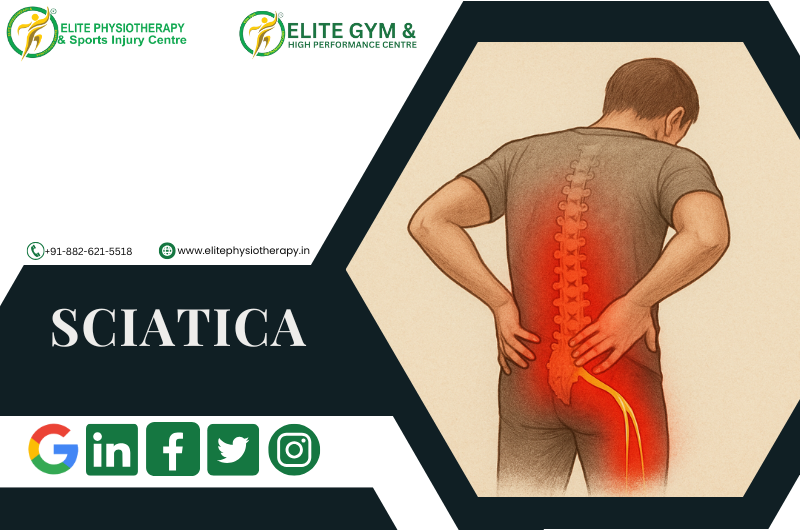A common condition that causes pain, numbness, or weakness along the sciatic nerve is sciatica. This nerve travels down each leg from the lower back through the buttocks. Our goal at Elite Physiotherapy and Sports Injury Centre is to improve function, reduce pain, and enhance quality of life through individualized treatment strategies.
What is Sciatica?
Pain that travels along the sciatic nerve route is referred to as sciatica. Usually, it impacts one side of the body. The pain might hamper everyday activities and ranges from mild to severe. Even while it usually goes away on its own, persistent cases need professional attention.
Causes of Sciatica
- Herniated Disc: The nerve root is compressed by a slipped disc.
- Spinal Stenosis: The nerve is compressed when the spinal canal narrows.
- Degenerative Disc Disease: Nerve discomfort is caused by disc wear.
- Spondylolisthesis: A nerve is pinched when one vertebra slides across another.
- Piriformis Syndrome: The piriformis muscle irritates the sciatic nerve.
- Trauma or Injury: Nerve damage can result from accidents.
- Infections or tumors are uncommon but possible causes.
Clinical Features, Signs, and Symptoms
- Sharp, shooting pain from the lower back to leg.
- Tingling or numbness in the foot or leg.
- Weakening of the leg muscles.
- Prolonged standing or sitting causes the pain to worsen.
- walking or carrying out regular tasks with difficulty.
Diagnostic Methods and Special Tests
An accurate diagnosis is essential for successful treatment. We conduct a comprehensive evaluation at Elite Physiotherapy and Sports Injury Centre by integrating a physical examination and patient history.
Common Diagnostic Techniques:
- The Straight Leg Raise (SLR) test: Involves raising the straightened leg to assess nerve root irritation. Pain reproduction suggests sciatica.
- Slump Test: The patient sits with their knee extended and their spine flexed. If sciatic symptoms show up, it’s positive.
- Crossed Straight Leg Raise Test: Lifting the unaffected leg while replicating symptoms indicates a disc herniation.
- Neurological Examination: Assesses strength, reflexes, and sensory abilities.
- Doctors may recommend imaging tests such as MRIs or CT scans to confirm disc herniation or stenosis.
Physiotherapy Management of Sciatica
At Elite Physiotherapy, we aim to reduce discomfort, increase range of motion, and stop recurrence. We emphasize individualized, evidence-based strategies with premium modalities.
1. Manual Therapy
- To increase spinal mobility and lower nerve pressure, we use soft tissue methods and joint mobilization.
2. Therapeutic Exercises
- Stretching: To relieve tension, focus on the piriformis and hamstrings.
- Exercises for Stabilization: Use low-load core strengthening to enhance spinal support.
- Exercises for Nerve Mobilization: Encourage sciatic nerve mobility without making symptoms worse.
3. High-End Modalities
A. Shock Wave Therapy
- Efficient in promoting blood flow and nerve regeneration to lessen chronic pain.
B. Super Inductive System (SIS)
- Provides deep electromagnetic pulses to the afflicted area to increase circulation and decrease inflammation.
C. High-Intensity Laser Therapy
- Reduces inflammation, discomfort, and promotes healing by penetrating deep tissues.
D. Dry Needling & Cupping Therapy
- Physiotherapists target trigger points and relieve tense muscles, which is especially beneficial for sciatica caused by piriformis syndrome.
4. Postural Correction and Ergonomic Exercises
- We provide home home-based exercise program for your posture correction that will help to minimize nerve compression.
Why Choose Elite Physiotherapy and Sports Injury Centre?
For sciatica, we offer a comprehensive, patient-focused therapy. Our skilled therapists and cutting-edge methods guarantee a quicker, secure recovery. We ensure long-term relief by tailoring each plan to each client’s unique demands.
At Elite Physiotherapy, we think that in order to assist patients properly heal from sciatica, we need to combine science, technology, and compassionate treatment.

